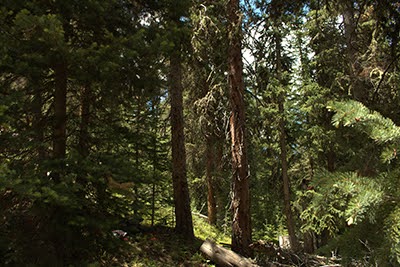Resilience
allow some change in current conditions, but encourage eventual return to original conditions
Management Goals
- Build resilience to drought, fire, white pine blister rust, windthrow, bark beetles
- Promote future-adapted native tree species and genotypes (drought) to create multiple ways for vegetation development
- Promote lodgepole pine for serotiny (fire resilience)
- Promote rust-resistant
- Pinus flexilis (limber pine) genetics
- Retain genotypes on site (refugia-like)
- Create a heterogeneous structure and reduce fuels in the matrix
- Promote wildlife habitat by retaining large diameter trees and snags
- Provide ecosystem services, including wood products, watershed health, recreation opportunities, and cultural resources
- Create opportunities for carbon sequestration by retaining larger trees

Strategies & approaches
Group selection to encourage lodgepole regeneration
Remove 20-30% of the basal area creating 3 2-acre groups and 3 1/2-acre groups
Place groups near overstory lodgepole pine to facilitate natural regeneration
Generally thin the matrix to promote healthier stands
Overall reduce the stand density by 10-20%
Remove Engelmann spruce <10” dbh, while maintaining mature/live spruce
Remove subalpine fir across all size classes >5” dbh
Keep lodgepole pine and any Populus tremuloides (quaking aspen) presentPassively allow any natural regeneration to establish within matrix
Favor aspen and lodgepole pine in open areas
Plant Douglas-fir (local source) and rust-resistant limber pineThe seedlots that will be used for Douglas-fir and limber pine reforestation in the resilience treatment will come from nearby populations, as shown on the maps. They both come from areas with average 1970’s climates that are drier and slightly warmer than the planting site, as indicated in the plots. The “period” corresponds to the climate projections for the average number of frost-free days and mean annual precipitation at the planting site in the 30 years centered on the 1970’s, 2020’s, 2050’s, and 2080’s. Numbers next to the seedlots on the map show the elevation in feet that the seedlot is from.

Maintain snags to help promote wildlife
Minimum of 4 snags/acre, retained in larger clumps if possible
Wildlife supported: boreal owls, lynx snowshoe hares, boreal toad, elk, deer
Reduce ladder fuel build-up while leaving some to promote roughness, soil moisture, and nutrient cycling
Lop and scatter (20-35 tons/acre) to encourage lodgepole pine height growth and seedling survival during drought years.
Allow for regeneration of spruce
Site Leads & Partners
Blair Rynearson, Zach Wehr, Carolina Manriquez, and John Twitchell from the Colorado State Forest Service are the site managers helping lead the Colorado State Forest ASCC Project. Mike Battaglia (Rocky Mountain Research Station) and Ethan Bucholz (Colorado State Forest Service) are scientists helping lead the research efforts for the site.
Key collaborators include Marin Chambers (Colorado Forest Restoration Institute) and Lance Asherin (USDA Forest Service Rocky Mountain Research Station, RMRS), Paula Fornwalt (USDA Forest Service Rocky Mountain Research Station, RMRS), Chuck Rhoades (USDA Forest Service Rocky Mountain Research Station, RMRS), Zachary Steel (USDA Forest Service Rocky Mountain Research Station, RMRS), Wade Tinkham (USDA Forest Service Rocky Mountain Research Station, RMRS), Katie Nigro (ORISE fellow working with the USDA Forest Service Rocky Mountain Research Station, RMRS), and the Forest and Rangeland Stewardship Department at Colorado State University.

Blair Rynearson
Manager Site Lead
State Forest Manager Colorado State Forest Service 59228 Highway 14 Walden, CO 80480 Phone: 970-723-4505 [email protected]

Mike Battaglia
Science Site Lead
Research Forester Rocky Mountain Research Station, USDA Forest Service Forest and Woodland Ecosystems Science Program 240 West Prospect Road Fort Collins, CO 80526 Phone: 970-498-1286 [email protected]

Ethan Bucholz
Site Lead
Forest Monitoring Program Manager Colorado State Forest Service 3843 Laporte Ave. Fort Collins, CO 80521 Phone: 314-757-0387 [email protected]
